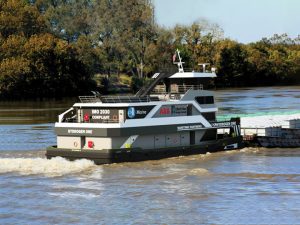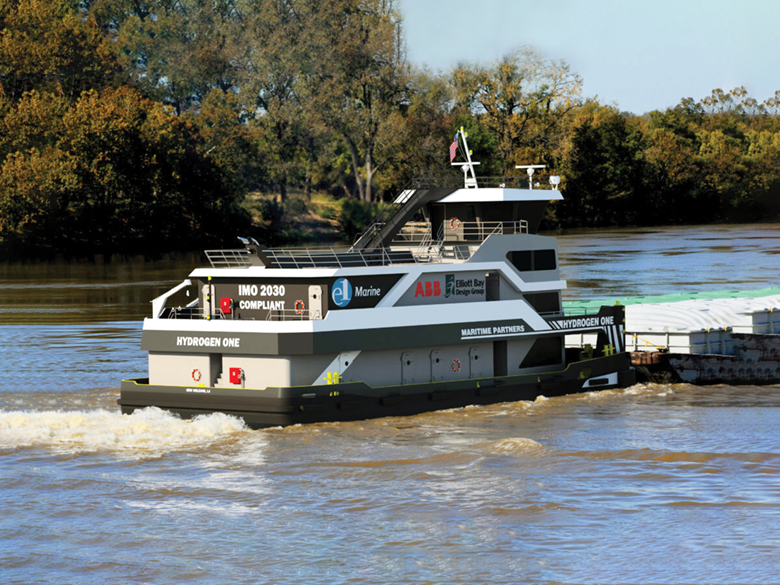Hydrogen One is on track to be the world’s first methanol-run hydrogen fuel cell working towboat.

The world’s first methanol-fueled hydrogen towboat M/V Hydrogen One is on schedule for its 2023 splash. A non-disclosed builder has been chosen and initial steel cutting was on schedule for summer 2022. The prototype vessel features a shallow draft design suited for extended trips along its planned base of operations—the ditch between Houston and New Orleans with inland water capabilities.
“The idea is to build it (Hydrogen One), get it fully operational, and put it through its paces before it goes to a customer to prove the technology, to demonstrate to the industry how it works, that it’s robust, safe, and functional,” said Mike Complita, Vice President of Strategic Expansion of Seattle-based Elliott Bay Design Group.
The firm’s role was to produce a Hydrogen One design that brought together all the components, namely the needs of commissioning party Maritime Partners, the hydrogen reformer technology from e1 Marine, and the expertise of engineer ABB in integrating the logic to bring it together. According to them, Hydrogen One will be IMO 2030 compliant and meet all requirements of the U.S. Coast Guard’s Subchapter M regulations.
“There is a segment in the market that includes smaller boats that can’t plug in every day,” explained Complita. These vessels don’t return to the same dock regularly or are off the grid for a week or more. “Nobody is investing in that part of the market right now,” said Complita of alternative fuels. Enter Hydrogen One.

How Methanol Fueled Hydrogen Works
Central to Hydrogen One are the e1 Marine reformers that convert the methanol and deionized water fuel mixture into pure hydrogen fuel. The hydrogen fuel is then used by fuel cells to produce electricity to power the electric engines. Electricity also can be stored in the onboard battery bank to power the hotel suite and serve as a limited backup propulsion energy source. Hydrogen One should be able to run exclusively on its battery bank for around half an hour in a pinch.
“The promise of the hydrogen fuel cells is that it produces three products,” explained Robert Schluter, Managing Director of Bend, Oregon-based e1 Marine. The three products are power, heat and water. The power is used in the form of electricity for Hydrogen One’s electric propulsion system. The heat also can be used aboard, and according to Schluter, about as much heat is produced as power.
“If you got a 100-kilowatt fuel cell, you’ll have approximately a 100-kilowatt heater,” said Schluter. The third product, water, is emissions in the form of steam, an environmentally friendly non-pollutant. Some carbon monoxide is also produced as emissions, albeit at lower levels than fossil-fuel internal combustion engines. Other pollutants like nitrous oxides, sulfur oxides and particulates are completely absent, another environmental bonus.
Hydrogen One will not carry pure hydrogen fuel in tanks, rather methanol that is mixed with deionized water and handled much like other hydrocarbon fuels. A primary advantage of hauling methanol fuel versus pure hydrogen is that it is a stable compound, where pure hydrogen is highly volatile. Methanol is already utilized in current infrastructure and evaporates when spilled.
“The engine room (of Hydrogen One) will look radically different,” than its internal combustion peers, Complita said. “In a traditional boat, the engines are down in the hull with the shafts and propellers. In this case, most of the hull is reserved for fuel capacity; methanol and deionized fresh water with space to blend the fuel, fans emergency pumps, etc.” All the propulsion equipment except thrusters or propellers are above on the main deck and includes the switch gear—the brains of the system—and the battery bank that controls all the communications and act as a power reserve.
“There will be a second deck level of machinery above the main deck,” Complita said. “That’s where the reformers and hydrogen fuel cells live.” The multi-level system follows the logic that everything that manages the methanol is in the hull. According to Complita, if the methanol does leak, it spills low and evaporates quickly. “We want to keep it low and it’s good for the weight to keep it low. The only thing the methanol does there is go through a pipe to the reformers at the top of the boat.”
The components that handle hydrogen fuel directly and produce power, heat, and water emissions are on the top level for both practicality and safety. Hydrogen and emissions evaporate upward into the atmosphere from the top position. The electric power-related systems are split between the upper and lower level as well as the switch gear on the main deck. At a glance, Hydrogen One’s exterior will look similar to a conventional towboat except for the second machinery level on the back that is normally open deck space.
Benefits and Considerations
Despite being new technology, one of the greatest potential benefits of the Hydrogen One system could be reliability and simplicity. “Historically, fuel cells are deployed for critical power applications when it absolutely has to work,” said Schluter, who cited high-security government communications buildings. Fuel cells have no moving parts, faster up times, and few points of failure when compared to diesel gensets on land. “We’re talking about literally five or six parts: four blowers, two fuel pumps and a couple of actuators. It’s not like an internal combustion engine with thousands of moving parts.”
Naturally the main thrust of the maritime space’s interest in hydrogen-powered vessels is related to climate change regulation, carbon emissions and looming IMO 2030 and 2050 goals. Hydrogen power represents a lower—or even negative—carbon footprint potential.
“We do produce CO2, but because it’s reusing methanol, it’s a reduction of 20% to 25% compared to internal combustion engines,” Schluter said. “And if you use renewable methanol, then you can get near zero. If you do carbon capture on top of that, now you’re talking about negative emissions. We can move more carbon out of the system than we produce.”
Methanol is a hydrocarbon-based fuel, and how one sources the methane—the building block of methanol—is what ultimately determines Hydrogen One’s overall Carbon Intensity Score (CIS). Currently most available methane is derived from fossil fuel sources to make gray methanol.
“Our CIS is like 91. But only around 20 of that is my process and the rest is where the methanol comes from,” explained Schluter. Sourcing methane from a non-fossil source, such as via agriculture or sewage treatment, brings the score down. The remaining carbon could potentially be scrubbed via promising new technologies. “If you can do carbon capture in combination with e-methanol, that’s how you can get negative (CIS) numbers,” he said.
A consideration for Hydrogen One’s systems is efficiency and range. Tanks of methanol fuel can outrange current battery bank technologies making Hydrogen One more peer competitive for certain maritime niches. But notably it takes approximately two gallons of methanol to yield the same power as one gallon of diesel. While this does translate to larger fuel tanks and loss of efficiency, Schluter reported that the natural efficiency of fuel cells claws back some of the efficiency penalties.
“An internal combustion engine runs in the high thirties (percent) of efficiency,” Schluter said. “A typical fuel cells runs 50% or 60% efficiency, and my technology runs in the low eighties. I get an almost 20% efficiency boost.”
Cost remains a major consideration for hydrogen technology. “If we didn’t have the regulations and the world pivoting to a clean energy future, everybody would stay with diesel because it’s much more cost effective,” Schluter said. “Essentially, we’re doing something that’s going to be at least twice as expensive from a power-train perspective and some applications could be three times.”
“Diesel has been around for 100 years, give or take,” Complita said. “The infrastructure is built around it, everyone around it understands it, everyone who writes the rules knows it. This (Hydrogen One) technology, like pure hydrogen or (liquefied natural gas) or battery, have their applications that they are well suited to. But they are not a single-source solution to all things like diesel.”
“There’s nothing intrinsically expensive about these technologies that we’re doing now that won’t be solved with volume,” Schluter said.
Hydrogen One’s Place in Maritime
Learning from Hydrogen One’s pioneering work life will be a major case study for methanol-fueled hydrogen systems. “We are working to be one solution for one segment of the market that’s not being addressed right now,” Complita said. “We’re not fooling ourselves to think this is the only solution or right solution for every application, it’s just not. But it does have a key place in the long-term market between now and at least the next 20 or 30 years.”
“The interest is definitely growing,” Schluter said. “We (e1 Marine) have another 14 (methanol-fueled hydrogen) vessels with a high probability of going to contract at the end of the year.”
Complita anticipated hydrogen vessels to be in high demand from specific clients. “Not every customer will want this, but the customers that do will want this boat. And operators won’t get contracts with certain customers unless they have a green solution. I believe that, within reason, the cost of vessels like Hydrogen One will be easily absorbed into the overall contracts that are being put out.” He compared the current and incoming regulations of carbon emissions with the transformative changes prompted by double-skin hull requirements after the Exxon Valdez oil spill.
Complita noted that the timing feels right with other efforts like Crowley Maritime’s all-electric tugboat eWolf, also in the works. “We want to get this technology online now working with the less ideal versions of the fuels (gray methanol) so this boat is ready for when the green options for methanol fuel come into play,” he said. “If we wait until those are ready, we’ll be waiting eight or ten more years. Let’s get it working now to plan and prepare.”
Norris Comer is a Seattle-based writer and author. His debut memoir, Salmon in the Seine: Alaskan Memories of Life, Death, & Everything In-Between is now available wherever books are sold. You can find him on Substack, Instagram and at norriscomer.com.

